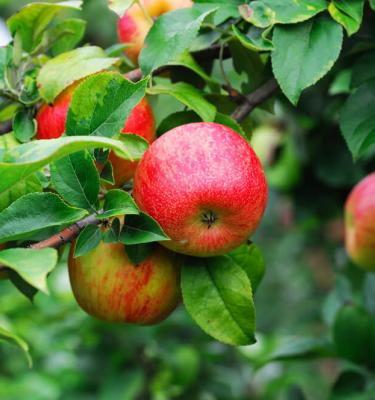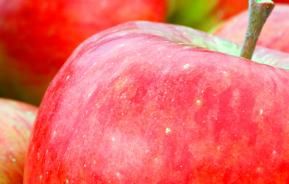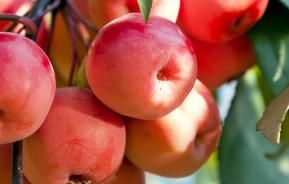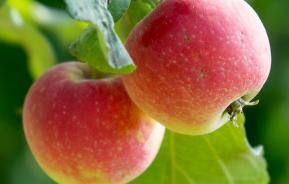Pruning apple trees doesn’t need to be complicated. Simply follow the straightforward steps in our apple tree pruning guide and your trees will reward you with a plentiful harvest!
Why prune apple trees?
Pruning apple trees encourages them to produce more fruit by removing old branches and stimulating new growth. The process of pruning also opens up the tree, allowing air to circulate and sunlight to reach ripening fruit.
This all contributes to the overall health of the apple tree, and a healthy tree means a larger harvest of better quality apples.
Tips for pruning your apple trees

Follow these handy tips for pruning perfection:
- Always take care when working at height, and only take on what you can do safely. Tripod ladders are more stable than stepladders. For jobs involving the removal of heavy branches and work high up, it’s best to use a professional tree surgeon.
- Work slowly. Take off a little at a time and keep stepping back from the tree to check the overall effect.
- When cutting off a large branch, take it back in sections from the end of the branch – this is safer and easier to control than chopping it off in one piece.
- When deciding which branches to remove, remember that horizontal branches bear more fruit than vertical ones.
- Make your cuts as flush with the main branch as possible. Avoid leaving little stubs that will die back and can introduce disease.
- Cut at an angle sloping away from a bud, so that rainwater falling on the surface of the cut drains away from the bud.
Your essential pruning equipment list
To prune your apple tree successfully, you will need:
- Sharp secateurs.
- Loppers.
- Pruning saw.
- Ladder.
When to prune apple trees
Free-standing apple trees are usually pruned in winter. This is because winter pruning stimulates new growth, whereas pruning in summer will reduce the plant’s vigour.
Left unpruned, apple trees can become congested with old branches that bear little fruit. Annual pruning keeps trees productive.
How to prune apple trees
Pruning techniques depend on how old your tree is and how well it has been pruned in the past. When pruning apple trees, you should aim to create an open goblet shape with four or five main branches.
You can buy apple trees that have already been pruned into a standard bush shape, or you can buy a year-old tree and do the formative pruning yourself. One-year-old trees come either as a single stem (called an unfeathered maiden), or a single stem with side shoots (called a feathered maiden).
The aim of the first year’s pruning of an unfeathered maiden is to produce side shoots, so if you can buy your tree as a feathered maiden, you will save yourself a year’s pruning time.
How to prune a young apple tree
Make sure you follow the below steps when you come to prune your apple tree.
Unfeathered maiden, 1st year
- Cut the stem just above a strong bud, around 75cm (2.5ft) above ground level. This will stimulate the tree to produce side shoots.
Unfeathered maiden, 2nd year
- The previous year’s pruning often results in a strong top shoot. If this is too vigorous and upright, remove it, cutting back to a shoot growing at a better angle.
- Select the best three to five side shoots to form the framework of the tree. Remove all other shoots.
- Shorten the selected side shoots by half, cutting to strong buds that are pointing in the right direction to produce a framework with an open goblet shape.
Feathered maiden, 1st year
- Cut the stem just above a strong side shoot, around 75cm (2.5ft) above ground level, so that there are three or four shoots below the cut.
- Remove any other lower side shoots.
- Shorten the remaining side shoots by half, cutting to strong buds that are pointing in the right direction to produce a framework with an open goblet shape.
Following year, for both feathered and unfeathered maidens
- On the main branches, cut one-third off the previous year’s growth, cutting to above healthy outward-facing buds.
- Don’t prune the side branches coming off the main branches unless they are damaged, and/or crossing or growing in toward the centre of the tree.
- Remove any strong upright shoots from the top of the tree.
- In following years, prune as for established trees.
How to prune established apple trees
When pruning an established apple tree, aim to remove no more than 10-20% of the tree canopy.
- First, remove any crossing, damaged, diseased or dead branches.
- Look for the previous year’s growth on each branch. Shorten this by a third of its length, cutting above a bud that is facing in the way you want the new branch to grow.
- Remove side shoots only if they are crossing or very crowded, otherwise leave them, as they will develop fruit buds the following year.
- Remove any strong shoots growing into the centre of the tree.
- Remove any strong shoots (suckers) growing from the base of the tree. Also remove any shoots growing straight upwards from the main branches – these are called watershoots and are the result of over-vigorous pruning in the previous year.
Pruning a neglected apple tree
If you need to do some serious renovation on a neglected apple tree, spread the work over two or three years to reduce the stress on the tree. Avoid very hard pruning, which can cause rampant growth.
To renovate a neglected apple tree:
- Remove all dead or damaged branches.
- Remove any lower branches that don’t get any light.
- Remove any branches growing into the centre of the tree.
- Remove any crossing branches.
There’s no need to be nervous about pruning apple trees! Simply take it step by step and you’ll soon see a difference - and remember that means more and better apples for everyone to enjoy.








